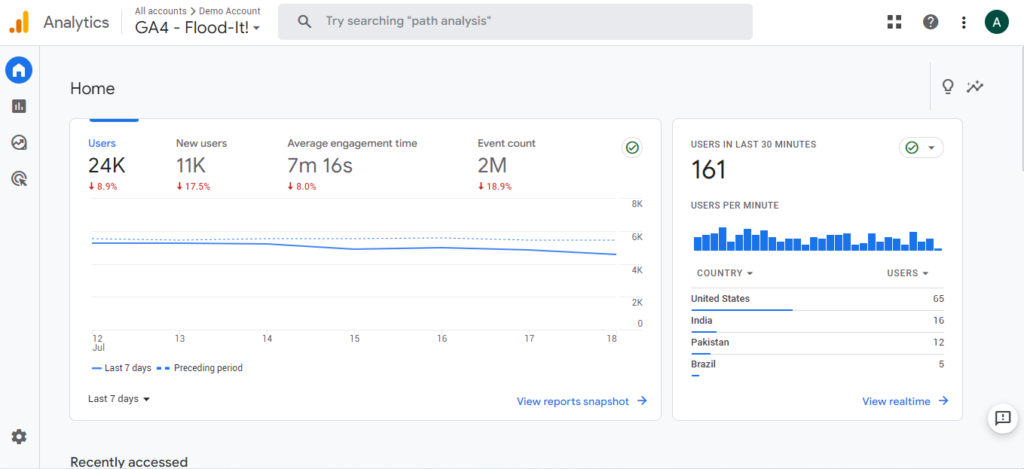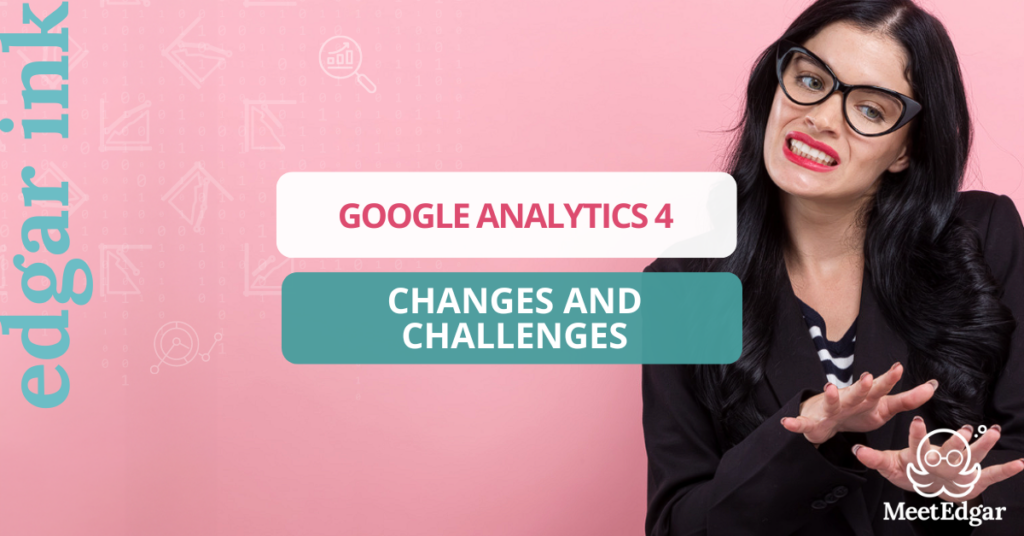Ah, data analytics, the magic potion that turns us, into into unstoppable marketing wizards! Without data, we’re just shooting marketing arrows blindly, hoping they hit something other than the office water cooler. And then here comes the transition from Universal Analytics to GA4 has caused some stress around the marketing world.
This first Q1 was dominated by the rush to “migrate” to GA4, which operates in a completely different way than its prefecessor. Starting July 1, 2023, Universal Analytics is no longer a full functioning dashboard and GA4 is the the primary property for Google’s data analytics, introducing new features and significant changes.
In this blog, I’ll be your trusty navigator, shedding light on the changes and challenges that come with GA4.
What is this GA4?
Google Analytics 4 (GA4) is the latest version of Google’s data analytics service1. Launched in October 2020, GA4 represents a significant shift from the old UA, bringing innovations to meet the current needs of data collection and processing, with features such as privacy controls and customer journey tracking on websites or apps.
While Universal Analytics was popular, changes in online privacy policies and consumer behavior demanded a new approach. GA4 places a strong emphasis on customer privacy, aligning with recent privacy regulations like GDPR and CCPA. The tool traces the complete customer journey across various platforms, utilizing AI and machine learning to offer in-depth insights into user interactions with your website and app. This new generation of GA is more powerful than ever2.
The Transition
Now comes the tricky part! As of July 1st, there’s no turning back. If you haven’t manually set up your GA4 account, don’t worry – a new GA4 property has been automatically created for you. If you are still insecure, my buddy Neil Patel has a cheat sheet for you here.
Today, we begin shutting down Universal Analytics as we welcome you to Google Analytics 4. This will not happen overnight, so some Universal Analytics properties may continue to process data. However, all properties have now been added to the queue, and those that have not…
— Google Analytics (@googleanalytics) July 1, 2023
Differences between GA4 and Universal Analytics
Tracking methodologies: cookies vs. events
In the old days of UA, cookies were the go-to method for tracking user behavior. But GA4 has taken a leap forward by embracing events. Unlike previous versions, GA4 doesn’t solely rely on cookies for gathering information. Instead, it employs an event-based data model to measure and track user actions. Events are activities on websites or apps, such as file downloads, video engagement, site searches, and scrolling to the bottom of a page.
This shift from cookies to events enables a more comprehensive view of user behavior. It also ensures greater privacy and compliance with current regulations while still providing valuable data for analysis and insights.
Emphasis on user-centric data rather than sessions
In the past, web analytics were obsessed with tracking sessions – how long a user stayed on a website. But GA4 recognizes the importance of the individual user and shifts the focus to user-centric data. It’s like going from counting sheep to actually understanding the dreams of each sheep. This shift allows businesses to truly understand their audience on a personal level and tailor their strategies accordingly.
Enhanced cross-device tracking and reporting
With GA4, businesses can finally track user interactions across multiple devices. It’s like having a personal tracker for your users, following them seamlessly from their phone to their laptop, and maybe even their smart fridge. This enhanced cross-device tracking opens up a whole new world of possibilities for marketers who want to engage with their audience on various platforms.
New interface
Universal Analytics has hit types, while GA4 has events – which may be the biggest challenge for marketing professionals to overcome. With a new reporting interface in place, users will need to adapt to the differences quickly to stay ahead, and some may not be willing to bother.

Challenges in Transitioning to GA4
Let’s face it – change is hard. But don’t panic. We are all in the same boat when it comes to this transition (Yep, I freaked out about this change a couple of times too).
Learning curve and adjustment period
Adopting GA4 comes with a learning curve as businesses familiarize themselves with the new interface and functionalities. While the fundamental principles of analytics remain consistent, there will be adjustments to processes and reporting. However, investing time and effort into understanding GA4 will pay off in the long run, as businesses harness its potential for enhanced data analysis.
Transitioning from UA to GA4 may require a bit of a learning curvebut don’t worry, for you are well-prepared to face it. Embrace the challenge like a brave sailor on a quest to conquer the mighty sea of outdated analytics. With a little patience and perseverance, you’ll conquer the GA4 landscape and emerge as a web analytics hero.
Migration process and potential data loss
For those who work in the digital marketing world, data collection plays a fundamental role. However, it’s essential to highlight that GA data is not compatible with GA4 and, it’s not possible to directly transfer your data to GA4. This enhanced version represents an enhanced version of GA with advanced features and a completely different architecture.
Moving your analytics from one platform to another can be a bumpy ride and you might experience a bit of data loss. Think of it as decluttering your analytics closet – getting rid of the old, irrelevant data and making space for the shiny new insights that GA4 has to offer.
Adapting measurement strategies for new data models
Google Analytics 4 utilizes artificial intelligence and machine learning to fill data gaps and provide more accurate insights. This modeling helps compensate for data loss due to cookie blockers and offers a more comprehensive understanding of user behavior on your website.
The introduction of new data models will require may require marketers to rethink their measurement strategies. It’s like learning a new dance move – it takes time to get the steps right. But once you’ve mastered the art of aligning your measurement strategies with GA4’s data models, you’ll be on your way to success.
New Features and Enhancements in GA4
Event-driven data collection
Say hello to the star of the show: event-driven data collection. GA4 opens up a whole new world of events that you can track, like button clicks, form submissions, and even video interactions. It’s like giving your website a VIP pass to the party of user behavior, where you can collect valuable insights and dance the night away with data-driven decisions.
Customer lifecycle reporting
GA4 understands that customers have a lifecycle. From first touch to loyal customer, GA4 allows you to track the entire journey. While GA3 only contains historical data, meaning it only looks at how the customers acted to date, GA4 offers machine-learning expertise to predict the future behavior of your users along with historical numbers.
Predictive analytics and AI-powered insights
GA4 takes web analytics to a whole new dimension with its predictive analytics and AI-powered insights. It’s like having a crystal ball that can foresee the future of your business. Whether it’s predicting customer churn or identifying potential high-value segments, GA4 equips you with the power to make informed decisions and stay one step ahead of the competition.
Check out these GA4 features and others in this awesome video made by The School of Digital Marketing:
Implications for Digital Marketers and Businesses
Rethinking measurement strategies and KPIs
With GA4’s arrival, it’s time to dust off those old measurement strategies and KPIs and give them a fresh coat of paint. It’s like renovating your analytics house – creating a space that aligns with the new capabilities of GA4. Embrace the opportunity to redefine your metrics and forge a path towards data-driven success.
Opportunities for improved personalization and targeting
GA4 opens doors to a world of improved personalization and targeting. Armed with the insights from GA4, you can create tailored experiences for your audience, boosting engagement, and building stronger relationships.
Impact on remarketing and attribution modeling
The transition to GA4 can have a ripple effect on remarketing and attribution modeling. It’s like a domino effect – one change in the analytics world can transform the way you reach your audience. GA4 offers new possibilities for honing your remarketing efforts and understanding the true impact of your marketing channels.
Take this opportunity to review your goals and strategies and it also might be a good idea to consider starting a Looker Dashboard. If you’re unsure where to begin, take a look at this template made by Smart Insights. They have created a dashboard template to help managers to complete a regular monthly review of the current effectiveness of their digital marketing using Google Analytics 4 with Google’s Looker Studio.
So what’s next for marketers?
Don’t shy away from the changes and challenges it brings. Instead, grab the bull by its data horns and charge forward. Embrace GA4, adapt your strategies, and unlock the true potential of web analytics. The digital world is waiting for you, brave marketer. It’s time to make your mark.
From your buddy,
Edgar
References


